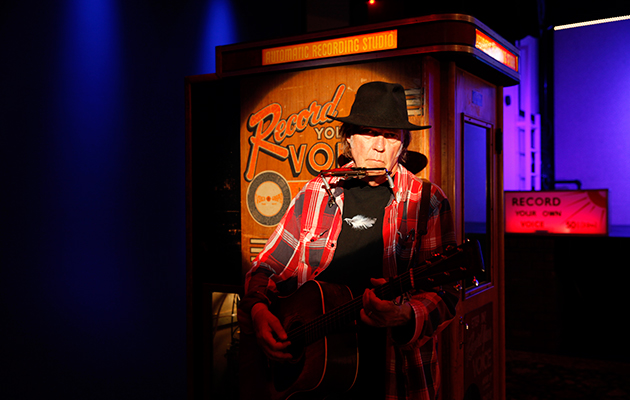Looking back on the weird and gripping narrative of Young’s last 12 months, a number of familiar, nagging patterns emerge. The old accomplices who resurface – Crazy Horse, Niko Bolas or Bruce Botnick, who now works for Young at Pono – and even the beloved songs he revisits. Young’s first album this year, A Letter Home, felt like a historical adventure as he covered songs by contemporaries including Dylan, Willie Nelson and Tim Hardin; many of which he’d played at Farm Aid 2013. A solo acoustic show Young performed sporadically between January and October, in New York, Hollywood, Dallas, Chicago, Boston and Philadelphia, as well as four benefit shows in his native Canada under the banner Honor The Treaties, was mainly devoted to classics drawn from the years 1966–1978. But much of what followed was recondite and wilfully contrarian. What was he doing? Was there a plan?
Reflecting on Young’s working practises during his glorious ’70s era, Poncho Sampedro says, “I remember we would go to Neil’s ranch to record. We’d stay there for a summer, maybe even nine months, just recording, recording, coming up with songs and partying, then Neil would come in and go, ‘Oh, shit, you guys. You’re not going to believe it, Warner Brothers called. We got to turn in a record. What do you think we should put on it?’ We never had the concept that we were making a record.”
However, Joshua V Smith can offer a first-hand account of Young’s more recent methods. An engineer at Jack White’s Third Man Records, Smith had been on hand then when Young visited the label’s Nashville headquarters on Record Store Day 2013. Later, Smith acted as engineer on A Letter Home, recorded in White’s 1947 Voice-O-Graph recording booth during sessions that took place between September 16 and 18, 2013. Smith recalls a week of hurried preparation adapting the Voice-O-Graph booth to White’s specifications, including adding a video screen so Young could watch himself at work. “Jack and Neil were both pitching ideas to each other,” explains Smith. “They both are very strong-minded, opinionated people. They want what they want, but they also worked really well together.
“Jack would say ‘What if you do this song?’ and Neil would be, ‘Yeah, yeah, that would be great.’ He had an assortment of guitars, including his Martin D-28, one of Hank Williams guitars. He and Jack were like ‘Hey, try this one for this song.’ So it seemed like they were deciding on things together.”
Smith estimates that together Young and White recorded “close to 20 songs” during the three days, with Young working “8 to 10 hours when he was there.” Smith was also on hand when Young recorded the album’s spoken word intro, a message to his late mother, Rassy, where Young reiterated his mission statement for 2014: “I still really have a lot of work to do here.”
“At first we had no idea he was gonna do it,” reveals Smith. “I think he and Jack just came up with that idea. He arrived on the second day and went in the booth. I was expecting a song and all of a sudden he just starts talking. For me, it just clicked. I don’t know if they went into the project knowing that was what they were going to do. But it just made it in to a real album, made it into a real project. It gave it so much purpose. I remember Mindy Watts, who was assisting on the record, getting a little teary-eyed.”
The recording was not without its difficulties, as Smith explains. “When it came to record the piano, we put Neil in the booth on a stool and pushed the piano up against the door. His back was facing the mic. It wasn’t the best place to fit. We just had to do whatever we could to get the piano recorded on there. At first, we tried where he’s kind of sitting outside with it, but it didn’t work. So we just ended up rolling it up against him pretty much and up against the booth. It was funny, Jack said for having a microphone in basically a phone booth, this has ended being a really complicated record.”

Perhaps the biggest revelation about A Letter Home was the original distribution method they had in mind. “They were gonna try to release it a month after and not announce at all,” explains Smith. “One idea was to plant some records in random record stores around the country, maybe even in the ‘Used’ section, and just let somebody find something and think ‘What is this? I never heard of this?’”
Young finally released A Letter Home on April 19, Record Store Day 2014. It is an odd though poignant addition to his cannon. There are clues, though, to its purpose. Ahead of its release, a news story announcing its arrival appeared on Young’s website credited to Homer Grosvenor; a sly reference to the house on Grosvenor Avenue, Winnipeg, where Young and Rassy lived during his first significant forays into music. Speaking to Uncut, Young even calls it “an historic art project.” To add to its peculiarities, it arrived while much of Young’s energy was otherwise engaged with promoting Pono.



